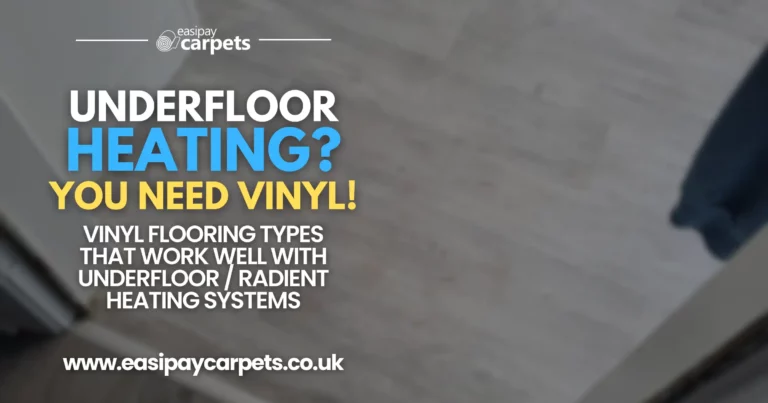

Vinyl Flooring and Underfloor Heating, Here's What To Look For!
Underfloor heating has become increasingly popular in homes across the UK, offering an efficient and comfortable way to keep your living spaces warm. This type of heating system provides an even distribution of heat and frees up wall space by eliminating the need for radiators. However, if you’re planning to install underfloor heating, choosing the right flooring is crucial. Not all flooring materials are compatible with underfloor heating, and even among those that are, some perform better than others.
Vinyl flooring is an excellent choice for underfloor heating, but it’s important to know which types of vinyl work best and how to install them properly to avoid issues down the line. In this guide, we’ll explore the best vinyl flooring options for underfloor heating and provide tips on ensuring your floors perform beautifully.
Why Choose Vinyl Flooring for Underfloor Heating?
Vinyl flooring is a popular option for homes with underfloor heating for several reasons:
-
Heat Conduction
- Vinyl flooring conducts heat efficiently, allowing warmth to spread evenly across the room. This means your home will warm up faster and stay warm for longer, making it a highly energy-efficient choice.
-
Comfort Underfoot
- Vinyl flooring is softer and warmer underfoot compared to tile or stone. It provides a comfortable surface to walk on, even without heating, and feels luxurious when paired with underfloor heating.
-
Durability
- Vinyl is known for its durability and resilience. It can withstand heavy foot traffic, is resistant to scratches and stains, and, when properly maintained, can last for many years.
-
Variety of Styles
- Vinyl flooring comes in a wide range of styles, colours, and textures, allowing you to achieve the look you want, whether it’s the appearance of wood, stone, or tile, with the added benefit of compatibility with underfloor heating.
Best Vinyl Flooring Options for Underfloor Heating
When it comes to choosing the best vinyl flooring for underfloor heating, there are a few key factors to consider: thickness, material composition, and installation method. Here are the top vinyl flooring options that work well with underfloor heating systems.
-
Luxury Vinyl Tiles (LVT)
- Why It’s a Great Choice: Luxury Vinyl Tiles (LVT) are a premium type of vinyl flooring designed to mimic natural materials like wood or stone. LVT is typically thicker than standard vinyl, which makes it better at resisting heat-related expansion and contraction. It’s also highly durable and water-resistant, making it suitable for any room in the house, including bathrooms and kitchens.
- Installation Tips: LVT can be installed using a floating floor system (click-lock) or glued down. Both methods are suitable for underfloor heating, but the glued-down method often provides better heat conduction. Ensure the adhesive used is compatible with underfloor heating.
-
Vinyl Plank Flooring
- Why It’s a Great Choice: Vinyl plank flooring, also known as luxury vinyl planks (LVP), is another excellent option for underfloor heating. Like LVT, vinyl planks are designed to replicate the look of natural wood or stone and offer excellent heat conductivity. The planks are typically thicker, providing more insulation and stability.
- Installation Tips: Similar to LVT, vinyl plank flooring can be installed as a floating floor or glued down. Floating floors are easier to install but may require an underlayment that is compatible with underfloor heating. Always check the manufacturer’s guidelines to ensure compatibility.
-
Sheet Vinyl Flooring
- Why It’s a Great Choice: Sheet vinyl is a continuous roll of flooring material that can cover large areas without seams, making it a great option for rooms prone to moisture. It’s generally thinner than LVT or vinyl planks, which means it heats up quickly and evenly. However, because it’s thinner, it may not be as durable in high-traffic areas.
- Installation Tips: Sheet vinyl is typically glued down, which is ideal for underfloor heating as it ensures maximum heat transfer. Make sure to use a suitable adhesive that can withstand the heat.
-
Rigid Core Vinyl Flooring
- Why It’s a Great Choice: Rigid core vinyl flooring is a newer innovation in the vinyl flooring market, offering the best of both worlds with a solid, stable core and a luxury vinyl surface. It’s designed to be highly durable, waterproof, and resistant to temperature fluctuations, making it an ideal choice for underfloor heating.
- Installation Tips: Rigid core vinyl flooring often comes with a click-lock installation system, making it easy to install as a floating floor. Ensure that the subfloor is prepared correctly to avoid any gaps that could affect heat distribution.
Tips for Installing Vinyl Flooring Over Underfloor Heating
To get the most out of your vinyl flooring with underfloor heating, proper installation is key. Here are some tips to ensure your floors perform optimally:
-
Check Compatibility
- Always check the manufacturer’s guidelines to ensure that the vinyl flooring you choose is compatible with underfloor heating. Some vinyl products have specific temperature limits and requirements that must be adhered to.
-
Acclimate the Flooring
- Before installation, allow your vinyl flooring to acclimate to the room’s temperature and humidity for at least 24-48 hours. This helps prevent expansion or contraction after installation, which could lead to gaps or warping.
-
Install Over a Suitable Subfloor
- The subfloor should be clean, dry, and level before installing vinyl flooring. Any imperfections can affect the performance of both the flooring and the heating system. Consider using a suitable underlayment if installing a floating floor to ensure even heat distribution.
-
Monitor the Temperature
- The surface temperature of the vinyl flooring should not exceed 27°C (80°F) to prevent damage. Use a thermostat to control the underfloor heating system and avoid setting it too high.
-
Avoid Using Thick Underlays
- If you’re installing a floating floor, choose an underlay that is specifically designed for use with underfloor heating. Avoid thick underlays as they can insulate the flooring from the heat source, reducing the system’s efficiency.
-
Allow for Expansion
- Vinyl flooring naturally expands and contracts with temperature changes. Leave a small expansion gap around the perimeter of the room to accommodate this movement and prevent buckling.
Benefits of Combining Vinyl Flooring with Underfloor Heating
Combining vinyl flooring with underfloor heating offers numerous benefits that make it an attractive option for modern homes:
-
Energy Efficiency
- Vinyl’s excellent heat conductivity allows underfloor heating systems to operate more efficiently, reducing energy consumption and lowering heating bills.
-
Even Heat Distribution
- Underfloor heating provides consistent warmth across the entire floor surface, eliminating cold spots and ensuring a comfortable environment.
-
Aesthetic Flexibility
- With the wide range of designs available in vinyl flooring, you can achieve the look you want without compromising on the practicality of underfloor heating.
-
Low Maintenance
- Both vinyl flooring and underfloor heating systems are low maintenance, requiring minimal upkeep to keep them in top condition.
Conclusion
When considering underfloor heating, choosing the right flooring is crucial to ensure comfort, efficiency, and durability. Vinyl flooring is an excellent choice due to its compatibility with underfloor heating, offering a combination of style, comfort, and practicality. By selecting the best type of vinyl flooring and following proper installation practices, you can create a warm, inviting space that you’ll enjoy for years to come.
Whether you opt for luxury vinyl tiles, planks, or sheet vinyl, always ensure that your chosen flooring is suitable for underfloor heating and that it’s installed correctly. With the right preparation and care, your vinyl floors will perform beautifully, keeping your home warm and stylish.
Easipay Carpets can help you get brand new flooring without the high up-front cost – by simply letting you spread the cost of the flooring over time instead. There’s no interest on our plans so you aren’t spending a penny more than you would buying it outright and we include underlay, door trims, carpet grippers and laminate beading for free. Prices start from just £10 per week!
It starts with a free home appointment and quote, to get booked in at a time that suits you, tap the “Get Started” button below and fill out the contact form!
Still Got Questions? Here's 10 FAQs!
Yes, vinyl flooring is suitable for underfloor heating, but it’s important to choose the right type and ensure proper installation.
Luxury Vinyl Tiles (LVT), vinyl plank flooring, and rigid core vinyl are among the best options due to their durability and heat resistance.
Yes, vinyl flooring can be installed over electric underfloor heating, but it’s essential to follow the manufacturer’s guidelines and monitor the temperature.
Use a thermostat to control the underfloor heating system and ensure the surface temperature of the vinyl flooring does not exceed 27°C (80°F).
If installing a floating floor, use an underlay designed for underfloor heating. Avoid thick underlays that can insulate the floor from the heat.
Vinyl flooring should acclimate to the room’s temperature and humidity for at least 24-48 hours before installation to prevent expansion or contraction.
Yes, sheet vinyl is suitable for underfloor heating and heats up quickly due to its thinness, making it an efficient choice.
A clean, dry, and level subfloor is essential. Concrete or screed subfloors are commonly used and work well with underfloor heating systems. If the subfloor is not level or has moisture issues, these should be addressed before installation to ensure the best performance of your vinyl flooring.
If properly installed and the temperature is kept within recommended limits, vinyl flooring should not warp or shrink with underfloor heating. However, extreme temperature fluctuations or improper installation can cause issues.
Caring for vinyl flooring over underfloor heating is straightforward. Regular sweeping or vacuuming and occasional mopping with a mild cleaner will keep the floor in good condition. Avoid using abrasive cleaners or steam mops, as excessive heat and moisture can damage the flooring over time.




